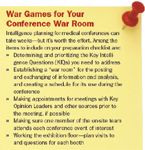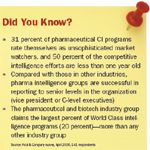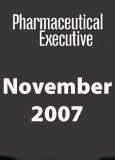The Intelligence Diaries
Pharmaceutical Executive
Business intelligence in a time of greater transparency is a whole new ball game. To play it well, be sure to look for surprising insights, expand your list of competitors of interest, and don't let Google be your only guide.
In today's pharmaceutical marketplace, there's no room for error; companies need to make all the right moves. Yet the industry's investment in intelligence—the wisdom that guides the brawn of Big Pharma—has been inconsistent, at best. A recent survey found that half of pharma companies' intelligence programs are less than one year old.
It's not that the concept of competitive intelligence (CI) is new—the field has existed within pharma for nearly 20 years. Rather, many companies suffer from "intelligence amnesia"—when companies build up intelligence programs only to drop them later. When new management enters the picture with an interest in CI, they have no knowledge of prior programs and must start the process from scratch. While not all companies contract complete amnesia, many lose their ability to assess their competitive surroundings. They may forget how to watch.
Wyeth was an example of the latter; it needed to regain its competitive capability. It was 2002, and the company was fighting several highly public battles: litigation on its diet drug Fen-Phen, a report citing problems with its hormone replacement therapy, and a series of related layoffs. These layoffs, recalls Craig McHenry, head of Wyeth's CI group, wiped out much of his staff. But McHenry soon viewed the layoffs as a sort of shock therapy.
Competitive intelligence had to prove itself again. So Wyeth began to change the way it scoured the market for new opportunities. "The biggest lesson for us, coming out of 2002, is that it's very difficult for a CI group to have a culture and a process that is drastically out of line with the rest of the organization's," says McHenry.
In large part, McHenry's wake-up call forced him to look at the past decade and see how the market had changed. Piece by piece, McHenry's CI organization began to help the company interpret the competitive signals faster and better than it did before.

War Games for Your Conference War Room
Most likely, your company needs to do the same if it is to succeed in today's competitive marketplace. Yet, many firms have failed to monitor the true markers of change. I've compiled notes from my CI files of nearly three decades to help companies get back in the game and to bring executives up to speed on best-in-class ways to recognize these markers—markers laden with threats...and opportunities.
Transparency Transformation
You hear a lot of talk about the drivers of today's business. But the driver that comes across most clearly is the need to curb healthcare costs—the proverbial elephant-in-the-room marker. The rise of healthcare costs at twice the rate of inflation is just not sustainable, whether employers foot the bill or whether we move to a national single-payer system. It's easy to focus on pricing alone. But look underneath the surface and you'll find an even more significant issue brewing—the forced transformation toward transparency.

Big Pharma, Big Budgets
Transparency comes in many different packages. It's more than just access to data on the Internet. It is about a confluence of forces that have peeled away industry secrecy, especially in the United States, over the last 10 to 15 years.
Marker #1: A crisis of reputation Last year, Harris Interactive's reputation poll of 21 industries placed pharmaceuticals among the most unpopular—again. Certainly, pharma's bad rep is nothing new, but things have gone from bad to worse. This crisis of reputation has forced pharmaceutical firms to report their trials, inform the public about changes in strategy, and disclose pricing of drugs.
"We are close to the bottom of the barrel," commented Wayne Rosenkrans, a strategist for AstraZeneca. "We are just a notch above the tobacco industry. We went from just being greedy to being evil about a year ago."

How Vasella Interprets Data-and the Future
It's not surprising then that, since 2000, pharmas worldwide have paid nearly $4 billion in settlements and fines.
Marker #2: The technology "revealer" It used to be that companies gained intelligence on how their drugs were faring in the marketplace through periodically updated reports from IMS Health. But new modes of delivery for medical data are creating a quiet revolution. Companies now gain this insight instantaneously by connecting with doctors at the point of prescribing and speeding intelligence directly to decision makers. To do this, the industry relies upon vendors that collect information from doctors with handheld devices, or from contract market researchers who survey physicians.
"Many biotech products are carried and distributed by specialty pharmacies...[and] may require special handling," says Allen Kamer, director of business development for Leerink Swann & Company, a healthcare-focused investment bank. "In order to stay current with...demand, companies require real-time data and information about their products."

Did You Know?
Marker #3: Government's heavy hand Over the past decade, the US government has forced open the doors to what used to be considered insider information. One of the best examples came in 1997 when FDA began requiring companies to register clinical trials and then posted the list on clinicaltrials.gov.
The transparency juggernaut driven by government is gaining speed. Even now, the US government has begun to move aggressively into the field of outcomes research, also known as health economics (which leads us to the next marker.)
Marker #4: Health economics and stealth agencies It used to be that slightly differentiating a drug was enough to get it on the formulary. Now, robust outcomes analyses that demonstrate significant advantages are needed if a drug's potential market success is to be realized.
The Agency for Healthcare Research and Quality, part of the Department of Health and Human Services, is at the forefront of applying health economics to the healthcare system. Its agenda may determine profit margins for the industry for years to come. Yet, AHRQ is virtually unknown by industry analysts.

Who Receives the Message?
"AHRQ is going to have a great impact on our industry," says Rosenkrans. "What it is doing is centered on comparative effectiveness, which has input into formulary decisions in ways that people don't really appreciate. I can't tell you how many times when I speak in front of audiences and ask them what AHRQ is that not a single hand goes up!"
Marker #5: Money, money, money... Thinning pipelines have placed a spotlight on Big Pharma's early pipeline. Before the mid-90s, companies never talked about early-stage programs. But the rise of the biotech industry and the increased focus on deal making have broadened the interest.
"Biotechs are very transparent in their early-stage programs, because that is their currency in financial markets," states Robert Gottlieb, a consultant and former editor of Pink Sheet. "It also allows them to showcase their science."
However, early-stage R&D programs hold the most risk, and the disclosure of these compounds' failure can lead to price swings and major market headaches. Bristol-Myers Squibb, for example, experienced this when, in 2000, it announced the negative side effects of Vanlev, an antihypertensive being touted as the company's next blockbuster. After more than 200 security fraud claims poured in, BMS withdrew the new drug application. Its stock quickly fell nearly 40 percent. The real and potent threats of such "ticking time bomb" lawsuits have spurred pharma firms to disclose more about their early-stage work—before the product's flaws are exposed late in the game and the market attacks.
Marker #6: The Internet and the rise of patient advocacy Patients have found their voice, and a Speaker's Corner on the Net where they can follow and influence trials. Case in point: Novartis had discovered Gleevec for chronic myeloid leukemia (CML). As the trials began their usual slow progression, Daniel Vasella, Novartis CEO, noticed something.
"Today's patients are a demanding lot," he wrote in the Magic Cancer Bullet. "They assert a right to decide and a right to the best treatment.... They are smarter than ever, discovering drugs at a very early stage of development, alerting their physicians to new drugs and therapies."
At one point, 42,000 messages appeared on a CML Listserv. Vasella acknowledges that patient activists used the Net to alter Gleevec's path, ultimately making it available to patients sooner than if they had waited for the usual trials.
Hitting the (Wrong) Mark
Given that most competitive intelligence teams are new, it seems strange that so many remain stuck, fixated on their traditional rivals. Mark Little of Covance, a global drug-development company, calls this "competitor myopia." "Too many professionals think their direct competitors are the only ones they are supposed to watch," says Little. "They need to look at all the threats—the payer, the technology, the supplier—before they set up their monitoring."
I recall one assignment that hinged on a competitive misconception. The stage was a war game we ran for a client's Asia-Pacific marketplace. The product was an antiviral drug they hoped would make inroads there. The drug had an excellent reputation in the West.
The client team focused on the usual pharmaceutical company rivals and their race to capture market share. But the real competition escaped their view—ancient Chinese herbal medicine. While everyone in the room knew that herbal medicines had no clinical trial evidence to support efficacy claims, it made no difference in the competitive landscape. The Chinese people believed in herbal remedies, and more than three-quarters of the market would rather drink an herbal potion than inject or swallow a tested pharmaceutical therapy.
Look around your healthcare niche and you will see other hidden-in-plain-sight threats (or opportunities). One example that many companies miss is nutraceuticals, which analysts peg to grow into a $15-billion-plus industry. Stuck in the old model of placing big bets on long-term clinial trials, intelligence programs may fail when they overlook new, more nimble entrants.
Finding the new markers If intelligence is about discovering the unexpected, where do you start looking?
It may sound surprising, but I have found job-posting sites a great way to see which entities are exploring an industry or therapeutic category. Check out a product or technology by typing in a few key search terms into job-hunting sites and you'll find a surprising number of nearly invisible competitors playing in your market.
For example, a quick search on obesity on Monster.com resulted in 160 postings. The companies listed included a wide range of traditional firms, but there were also a number of biotech startups, a medical device company, and a host of medical and wellness centers conducting research.
Obesity is a relatively new market, so rivals may pop up anywhere. Perhaps a new device or a lifestyle treatment will prove more economically effective than a pill. If so, the wellness approach, or a homeopathic or herbal remedy, may win over the pharmaceutical drug solution.
Searching job-posting sites is one fresh way to research the healthcare landscape. But consider these additional alternatives that offer a new way of watching for future opportunities or threats.
- Ask yourself: What genetic population is a potential competitor targeting? Watch this marker, which may lead to a drug-diagnostic launch. If a rival can offer both the drug and a diagnostic as a package, that may give it a leg up in narrow formulary lists.
- Track blogs and get onto Listservs Patient-advocacy groups have learned a lot from Gleevec. We have witnessed patient groups shaping clinical trials in many therapeutic areas and changing the way biotechs position their early-stage drugs.
- Pay attention to investor conferences The cardinal rule of intelligence: Wherever money is exchanged, so is information. It's not just about scientific conferences any more. "I am seeing more of a convergence among the biotech, pharma, and the investment community than ever before," says the former Pink Sheet editor Gottlieb. "Some of the investor conferences have become big forums for discussions of pharmaceutical business development and competitive activity."
- Understand the economics Watch the health economics, and remember that whoever wins the race to the formulary wins the game. The overall clinical and financial effectiveness of a drug or a treatment may overshadow the science.
Blogs and Chat Rooms: Test the Noise
I have met too many executives who dismiss blogs and chat rooms, such as cafepharma.com, as wastes of time. Unsubstantiated. Bombastic. Self-important. Dismiss it you might, but it is all part of the transparency—the not-yet-vetted insights—that could reveal a rival's future moves.
For example, in between the bragging rites and testosterone flowing through Cafepharma diatribes, we learnt how salespeople think about the products they sell or how they view competitive positioning. These blogs and discussion boards may not reveal strategic secrets, but they will uncover a competitive dynamic. Think of discussion forums as another channel on your television set, another window on the world in which you compete.
Below are a few noteworthy blogs worth considering.
DrugWonks "Debating today's drug policies" is the motto of this blog, which comes from the Center for Medicine in the Public Interest and is championed by Peter Pitts, ex-FDA communications officer. It analyzes FDA issues, Medicare, and healthcare spending, among other topics.
In the Pipeline In the Pipeline blogs about R&D. Written by a drug-discovery pro with his PhD in organic chemistry, entries are indexed into categories such as Life in the Drug Labs.
Patent Baristas This clever blog, written by two patent attorneys, tracks and comments on intellectual property issues and the biotech and pharmaceutical industries. A survey of recent articles included discussions on generics, patent infringement, FDA warning letters, and IP legislation.
Pharma's Cutting Edge Written by a life sciences consultant, this blog considers such issues as clinical research, pharma sales and marketing, drug safety, and regulatory issues.
Doing it Better
Good things come in threes, and world-class intelligence programs are no exception. It used to be that companies could apply brute force, such as defensively filing endless numbers of patents and increasing clinical trial maneuvering to possibly leapfrog a rival's market launch. Today, strategic intelligence leaders would do better to ensure that their companies display these important characteristics of success:
Build a common competitive language Organizations that fail to identify and declare an explicit way to look at the market open the door for any and all flavor-of-the-month models (some very valid) to embed themselves. The result is lots of people chasing lots of models, each demanding different pieces of information. BCG Matrix, Economic Value Added, McKinsey Seven S's, PEST, SWOT, Value Chain—the list is nearly endless. The result of pursuing each model is like a dog chasing its own tail: there's lots of information but no insight. Pharmaceutical companies are filled with strategic static from too many disconnected frameworks, each requiring different information, often producing no new insights, just a lot of PowerPoint slides.
Covance's Little has pushed a common language in Harvard Business School Professor Michael Porter's five-force model for assessing competitors (direct rivals, substitute products, new entrants, powerful customers, and suppliers). This model helps explain why the pharma industry has enjoyed such a profitable history, and through its lens, the industry can now see more than just its traditional rivals.
Encourage "watch team" diversity Wyeth's McHenry began to broaden his organization's intelligence reach by making sure CI specialists seed themselves throughout the company. His warning: "Insights don't happen in a vacuum." If he hears of a new task force in the sales, marketing, or trial operations departments, he asks for a seat at the table. He does not want to steer the ship, he merely wants better ways to alert and advise management.
Get on the street and away from Google When I asked a group of 100 European competitive intelligence analysts how many attended scientific conferences to garner competitive insights, fewer than one-third raised their hands. All hands should have shot up.
These analysts are smart. They are also isolated. Too many stay at their desks, busy on their computers. Most have not visited their labs, observed clinical trials, and do not have regular meetings with key opinion leaders. Far too many are overexposed to Google, believing that it can give companies all the answers.
Medical and scientific trade shows are great for gaining street knowledge, but scientists often attend such congresses to learn just about a treatment or compound. One industry congress that lasts a few days offers a more fertile intelligence opportunity than a thousand hours of information collection over the phone.
Pharmaceutical and biotechnology companies will never be able to return to the competition of the past. Patients have more power. Lawsuits abound. The industry must rebuild its reputation. The Internet has changed data distribution forever. Add new technologies and unpredictable regulatory hurdles, and you will understand how important astute intelligence has become to today's strategic decision making.
Leonard M. Fuld is president and founder of Fuld & Company, a pioneering competitive intelligence consulting firm. His most recent book is The Secret Language of Competitive Intelligence (Crown Business, a division of Random House, 2006).

The Misinformation Maze: Navigating Public Health in the Digital Age
March 11th 2025Jennifer Butler, chief commercial officer of Pleio, discusses misinformation's threat to public health, where patients are turning for trustworthy health information, the industry's pivot to peer-to-patient strategies to educate patients, and more.
Applying Porter’s Five Forces to Portfolio Management in Pharmaceutical R&D: A Strategic Roadmap
March 17th 2025The increasing costs and complexity of R&D in the pharmaceutical industry have necessitated the adoption of strategic portfolio management to optimize resource allocation and enhance competitive advantage.
Navigating Distrust: Pharma in the Age of Social Media
February 18th 2025Ian Baer, Founder and CEO of Sooth, discusses how the growing distrust in social media will impact industry marketing strategies and the relationships between pharmaceutical companies and the patients they aim to serve. He also explains dark social, how to combat misinformation, closing the trust gap, and more.